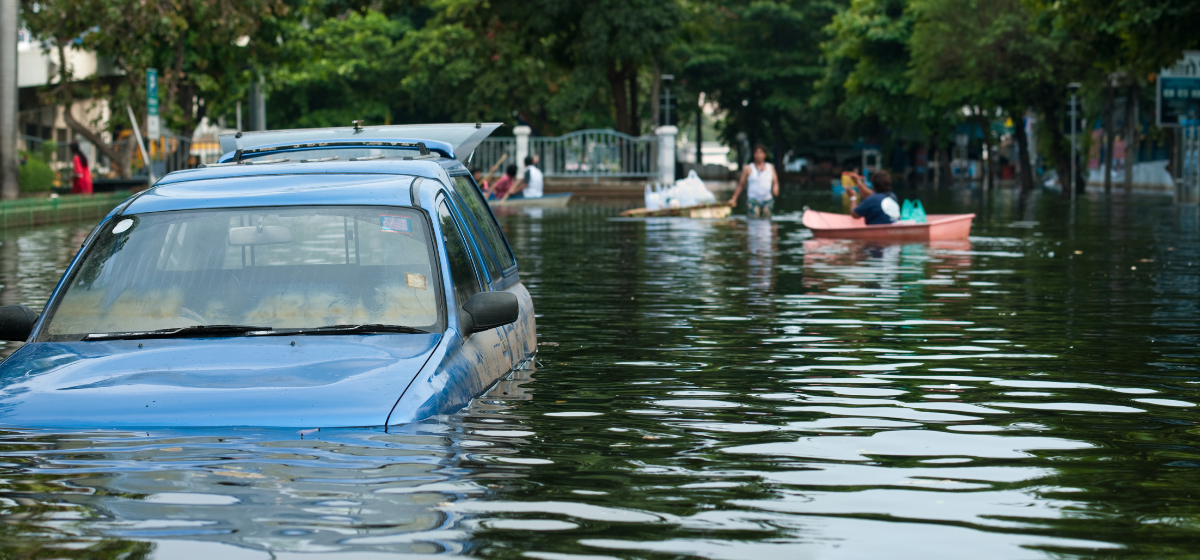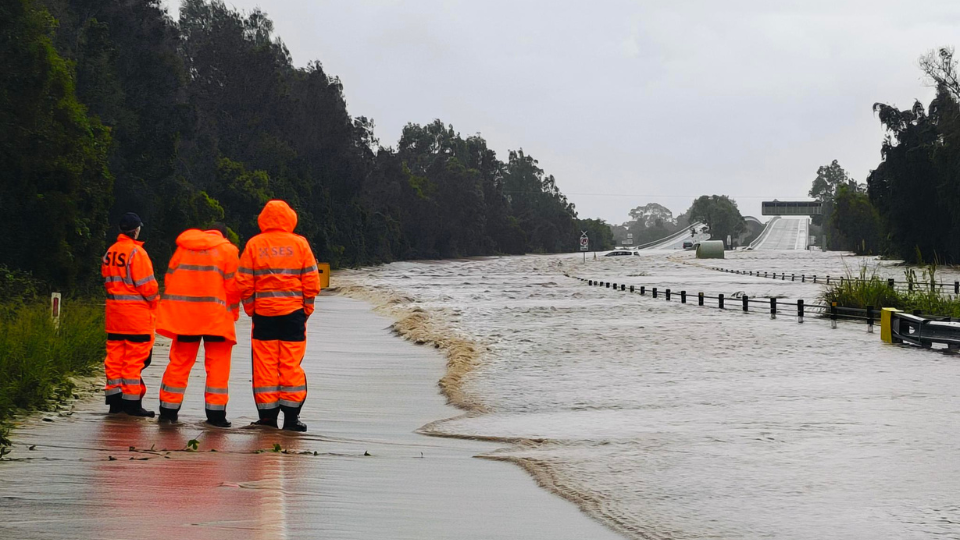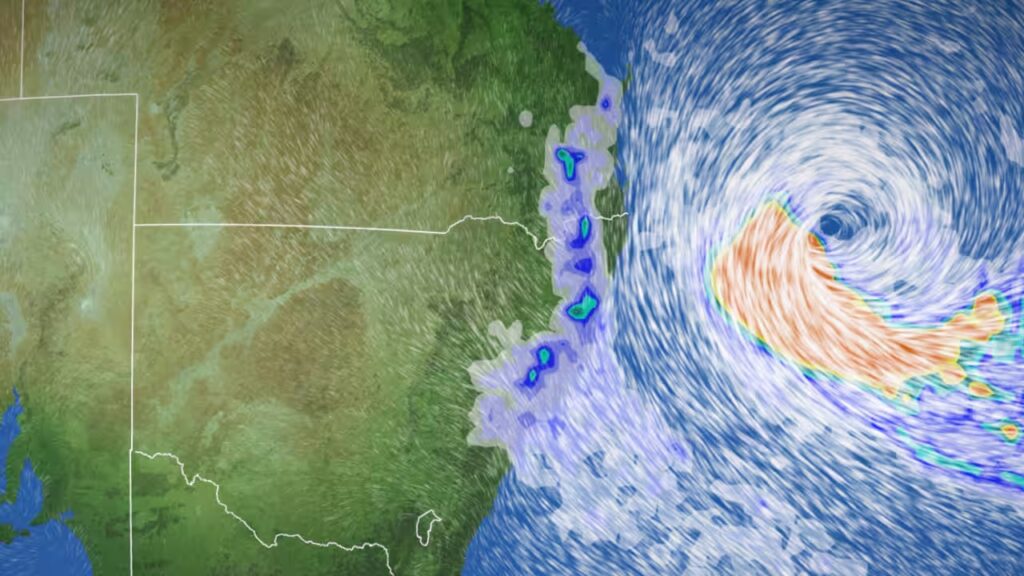Australian summers used to be our favourite season. Now, climate pollution is making our weather more volatile and unpredictable. Summer has become a season many feel anxious about.
Climate pollution, driven by the burning of coal, oil and gas, has pushed us into a dangerous, costly new era of escalating extreme weather events. Last summer highlighted the complex interaction of different climate drivers against the backdrop of a rapidly overheating planet. Far too many Australians have suffered through prolonged droughts, deadly heatwaves, catastrophic bushfires, and devastating floods. This summer, we need to be prepared for anything.
Communities and emergency services are already being pushed to their limits. We are now at higher risk of compounding events – multiple extreme events that occur at the same time, or in rapid succession. For example, immediately following the Black Summer bushfires in New South Wales, people impacted by fires faced multiple flood emergencies over the following two years, seriously impacting community recovery.
This summer will be no different. Heatwaves and extreme heat with little reprieve overnight are on the cards for many Australians. The Bureau of Meteorology is expecting above average maximum temperatures for large parts of Australia, and above average minimum temperatures across almost all of Australia. There is an increased chance of unusually high maximum temperatures across Tasmania, western WA, parts of south-eastern South Australia and western Victoria.
We could see intense rainfall and possible flooding in parts of eastern and north-western Australia. December is being forecast to be particularly wet, with unusually high rainfall tipped for parts of Queensland’s coast, Cape York Peninsula, southern New South Wales, eastern parts of Victoria, Tasmania and South Australia, northern Western Australia and parts of the interior.
And rain and rising temperatures could mean that many Australians are at risk of debilitating and in some cases deadly mosquito-borne diseases.
Our current disaster planning and management systems are no longer fit for purpose to keep Australians safe in our changing climate. This past year, we have seen how consecutive, record-breaking events and unnatural disasters can at times overwhelm emergency services and devastate communities.
So what can we do to ensure we’re as prepared as we can be for the summer ahead?
- Prepare for floods
- Prepare for fires
- Prepare for thunderstorm asthma
- Prepare for cyclones
- Preparing for mosquito-borne disease
Preparing for floods:
With climate pollution we can expect more of our rain to fall in the form of short, intense downpours, which raises the risk of flooding. Across Australia, there has already been an observed increase in the proportion of rain coming from short-duration (hourly and sub-hourly) heavy rainfall events.
Floods pose the greatest climate risk to Australian homes, a fact reflected in our Climate Risk Map, where 80% of the properties classified as high risk by 2030 are most at risk of riverine flooding. Riverine flooding is when a river exceeds its capacity, inundating nearby areas.
Floods can also impact critical infrastructure which can have ongoing effects on health and well-being. For example, floods frequently damage power transmission and sometimes power generation, which also has knock-on effects like leaving people without access to refrigeration or the Internet and mobile phone reception. Extreme weather events such as intense rainfall and floods can reduce water quality and availability, jeopardising water security and affecting human health.
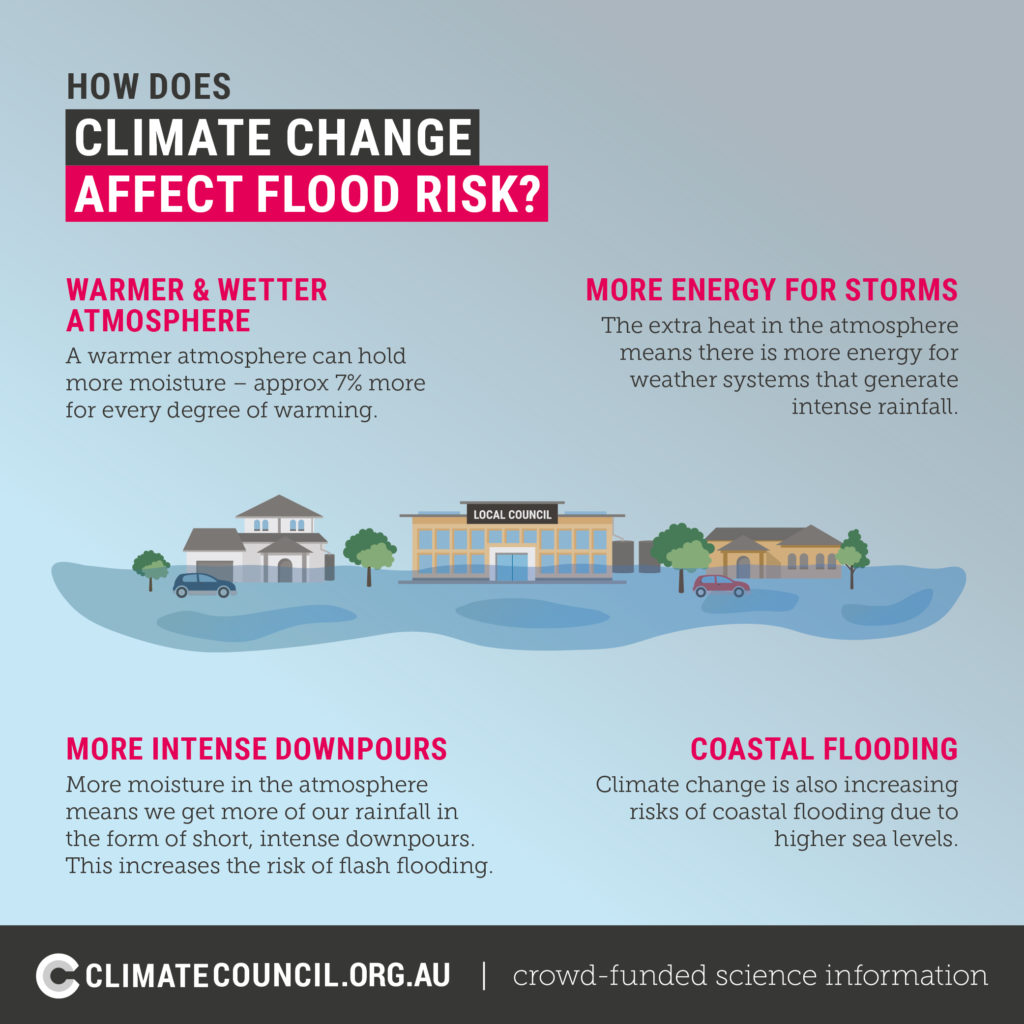
What to do:
It doesn’t have to be raining in your area for a flood to impact you. In an emergency, the situation can change rapidly. You could be at risk even if you’ve never seen floodwaters near your home. Find out if your home is at risk of flooding here. Before a flood arrives, it’s important to: ask, learn, plan and prepare.
Make a flood plan and an emergency kit ahead of time and make sure everyone in your household knows what to do if there is a flood.
Protect your health during a flood by:
- Familiarising yourself with your community’s evacuation route and warning signals, and identify areas prone to flooding or landslides
- Chlorinate or boil all water for drinking and food preparation
- Promote good hygienic practices and safe food preparation techniques
- Avoid walking or driving through flooded areas and standing water
- Throw away any food that has come in contact with floodwater
- Protect against mosquitos
Flood events not only have a severe impact on human life and the economy, but also on our beloved pets, precious wildlife and valuable livestock – learn how to care for your furry friends in flooding events here.
Preparing for fires:
A fire needs to be started (ignition), it needs something to burn (fuel) and it needs conditions that are conducive to its spread (weather). Climate pollution can affect all three of these components in complex ways, but it is weather on a particular day that is the most crucial determinant of fire spread, intensity and impact. At higher temperatures, fuel is ‘pre-heated’ and is more likely to ignite and to continue to burn. Once a fire is ignited, very hot days with low humidity and high winds are conducive to its spread.
What to do:
A well prepared home is more likely to survive a bushfire. Even if your plan is to leave early, the more you prepare your home, the more likely it will survive. A well prepared home can also be easier for you or firefighters to defend, and is less likely to put your neighbours’ homes at risk. Plus, you will also be better protected if a fire threatens suddenly and you cannot leave.
Tips to prepare for a fire
- Know your fire danger rating
- Know the bushfire alerts and warnings
- Prepare your emergency kit
- Prepare your home and property
- Manage vegetation around your property
- Prepare your pets and livestock
Read more here for recommendations on how to keep your garden fire preventative.
Check out our full list of fire and emergency chiefs recommendations to Federal Government here.
Find out your home’s risk level here.
Preparing for Cyclones:
In our supercharged climate, when tropical cyclones form they form in a climate that is warmer, wetter, and more energetic than before. This surplus of energy translates to cyclones that are faster to develop and faster to intensify. The added heat also leads to greater windspeeds and water-carrying capacity, which means cyclones are far more destructive.
The Bureau of Meteorology has predicted a greater chance of intense tropical cyclones developing up north over this summer.
Take precautions to reduce the risk of damage or injury from these factors before a cyclone hits.
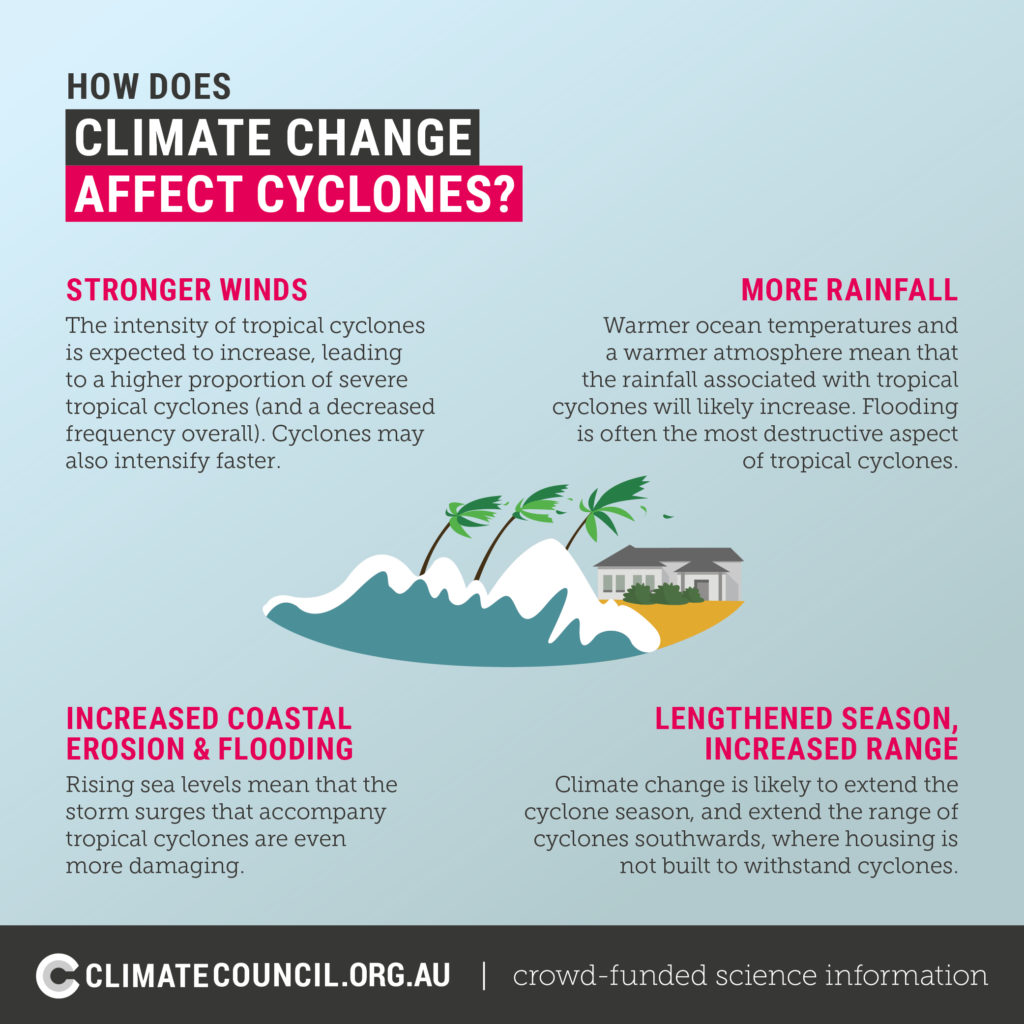
What to do:
Similar to being ready for a flood or fire, the best way to be prepared is by having a plan well ahead of any potential cyclone by:
- Preparing your property
- Knowing when to take action
- Packing your emergency kit
- Staying informed
More details on how to prepare for a cyclone here, and here as well.
Preparing for mosquito-borne disease:
A warming and less stable climate increases disease rates, particularly by bringing people and disease-causing organisms closer together. Notably, higher temperatures and increased rainfall have expanded the range of mosquitos and contributed to outbreaks of dengue fever and malaria.
Japanese encephalitis virus (JEV) is a mosquito-borne arbovirus endemic to the Asia-Pacific that causes high morbidity and mortality in those who develop symptomatic disease. Prior to 2021, only five locally acquired cases had been detected in Australia, all in northern Australia. Following a sentinel case (an unexpected occurrence involving death or serious illness) in 2021, widespread dissemination of JEV was detected in northern and south-eastern Australia, accompanied by an increase in locally acquired cases, which have been detected as far south as Victoria. This expansion has occurred in the setting of warmer and wetter conditions under the influence of climate change. On 4 March 2022, Australia’s Chief Medical Officer declared the JEV outbreak a Communicable Disease Incident of National Significance (CDINS). This occurs when a communicable disease or condition has potential to severely threaten human health and safety.
How to stay safe/be prepared
There are two ways to protect yourself from Japanese encephalitis virus infection:
- Avoid being bitten by mosquitos
- Receive a vaccination for the virus.
You can protect yourself from being bitten by mosquitos by:
- Applying and regularly reapplying an effective insect repellent on exposed skin
- Wearing long, loose fitting clothing when outside
- Ensuring accommodation, including tents, are properly fitted with mosquito nettings or screens
- Using insecticide sprays, vapour dispensing units (indoors) and mosquito coils (outdoors) to clear rooms and repel mosquitoes from an area
- Covering all windows, doors, vents and other entrances with insect screens
- Removing any water-holding containers where mosquitoes may breed.
If you believe you may be infected with the JEV or any other mosquito-bourne disease, seek urgent medical assistance.
History may no longer be the best guide for what to expect in the future. By changing the climate, we are changing the conditions under which all weather forms. Accurately predicting extreme weather is only possible much closer to when the event is about to happen, and even then it can be difficult to accurately forecast extremes.
This new era of climate-fuelled unnatural disasters carries severe consequences for disaster and emergency management in Australia – yet another compelling reason for Australia to accelerate efforts to slash climate pollution further and faster. Many communities are already leading the way to a safer future, with initiatives such as community energy, active transport, and community resilience hubs. Governments need to back these community-led efforts, and help to prepare us all for worsening extreme weather.If feelings of stress, sadness or frustration overcome you when thinking or hearing about the state of the planet and potential upcoming unnatural disasters, you’re not alone. In fact, research shows that 78% of Australian voters are worried about climate change. More tips for dealing with eco-anxiety and stress here.
We have the solutions needed to safeguard our planet for future generation at our fingertips—we just need the political will to make it happen.
Every positive action adds up.
Extra resources and services
SES: 132 500
Australia wide emergency services website
NSW State emergency services website
You can make your own emergency plan here.
The New South Wales Government Local Land Services – 1300 795 299 for emergency support in managing livestock or flood impacts
The Queensland Government Business Queensland service provides advice and contact numbers for preparing animals for natural disasters
To find your closest qualified wildlife rescue service or vet, you can download this app.
Evacuation centres:
Mental health helplines:
Lifeline provides 24-hour crisis counselling, support groups and suicide prevention services. Call 13 11 14, text 0477 13 11 14 or chat online.
Beyond Blue aims to increase awareness of depression and anxiety and reduce stigma. If you or a loved one need help, you can call 1300 22 4636, 24 hours/7 days a week or chat online.
Head to Health gives advice and will connect you to local mental health services. Call 1800 595 212.
Kids Helpline is Australia’s only free 24/7 confidential and private counselling service specifically for children and young people aged 5 – 25. Call 1800 55 1800.
headspace provides free online and telephone support and counselling to young people 12 – 25 and their families and friends. Call 1800 650 890, or chat online.
Wildlife helplines:
NSW: WIRES 1300 094 737
VIC: Wildlife Victoria (03) 8400 7300
QLD: RSPCA QLD 1300 ANIMAL
SA: Fauna Rescue of SA inc 08 8289 0896
WA: Wildcare WA (08) 9474 9055.
ACT: ACT Wildlife 0432 300 033

